Pros
Cons
Introduction
Product Tour
Front
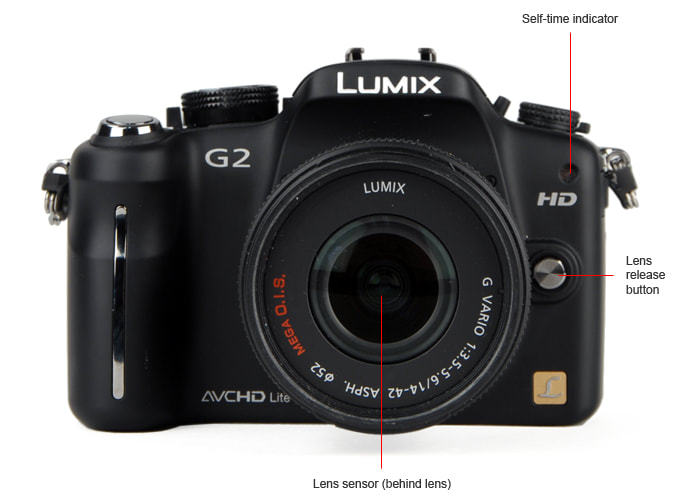
Back
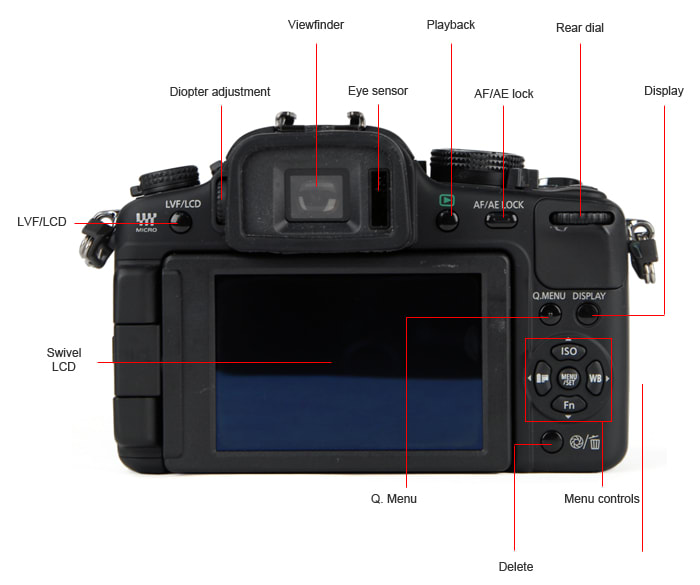
Sides
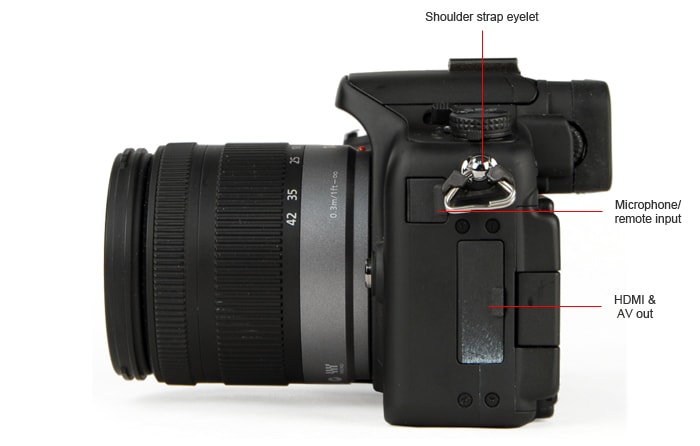
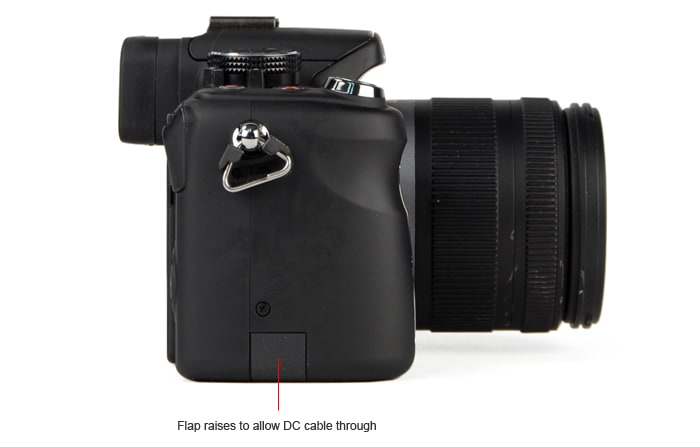
Bottom
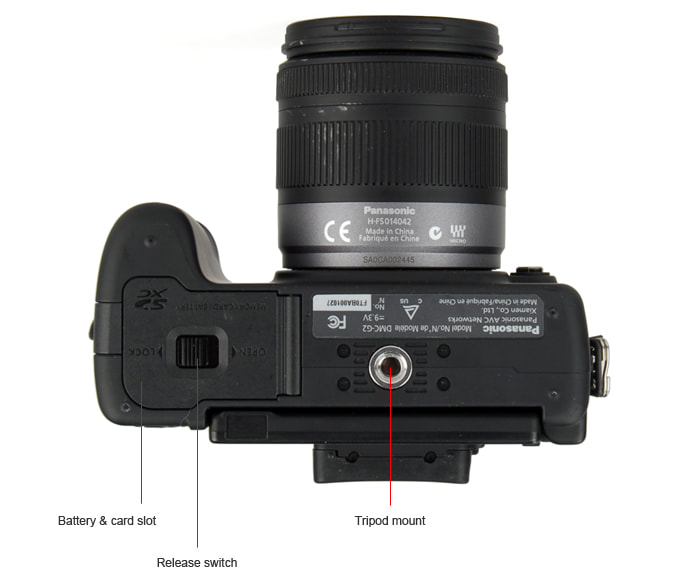
Top
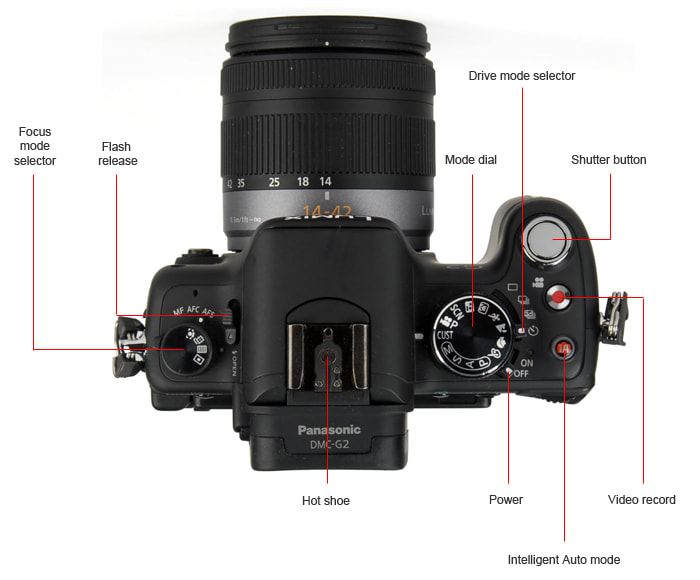
** Size Comparisons **
** In the Box **
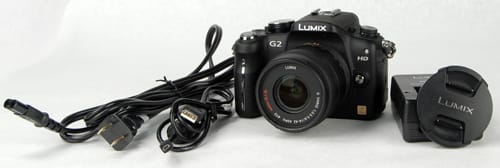
• Panasonic DMC-G2 camera body
- with body cap
• Interchangeable lens (LUMIX G VARIO 14–42mm, F3.5-5.6)
- with detachable lens hood, lens cap, lens rear cap, and lens storage bag
• Battery pack (DMW-BLB13PP)
• Battery charger / AC adapter
• AC cable
• AV cable
• USB connection cable
• CD-ROM
• Shoulder strap
• Stylus pen
Color
**Color Accuracy *** (13.94) *
The Panasonic G2 produced more accurate color than either of the company's previous Micro Four Thirds models—in fact, for color accuracy alone, the G2 outstripped all of its competitors except for the remarkably accurate Olympus cameras. Compared to most traditional SLRs, however, the G2 underperforms in color accuracy. Click here for more on how we test color.
The G2 offers nine film modes: six in color and three in black and white. The most accurate of these modes turned out to be Smooth, which turned in a color accuracy of 2.87 and a was only slightly undersaturated at about 98%. Red, pink, dark blue, and dark green were the most accurate shades for the G2, while yellow, turquoise and lighter shades of green and blue turned out to be trouble spots.
The following chart shows same size crops of each color patch from the test chart, shot in the most accurate color mode for each comparison camera.
NOTE: Because of the way computer monitors reproduce colors, the images above do not exactly match the originals found on the chart or in the captured images. The chart should be used to judge the relative color shift, not the absolute captured colors.
Color Modes*(5.00)*
The G2 offers nine different preset 'film modes,' which will be familiar to those that have used a Panasonic Micro Four Thirds camera in the past. Each modes impacts contrast, sharpness, saturation, and noise reduction differently. Six of those film modes impact color: Standard, Dynamic, Nature, Smooth, Nostalgic, and Vibrant. There are also three black and white film modes: Standard, Dynamic, and Smooth.
Including high-ISO noise reduction settings as part of color mode settings is a peculiarity. This means that the most accurate color presets may come hand-in-hand with some amount of noise reduction. There's no simple way to just turn off noise reduction altogether.
There are a couple of custom 'my film' presets that you can also enable; you can manually adjust contrast, sharpness, saturation, and noise reduction—each along a five-step scale—then save your adjustments for later.
The chart below shows same-size crops from test shots of the ColorChecker chart in each color mode. Dynamic and Vibrant modes were highly oversaturated: 112% and 124%, respectively. Nostalgic mode (not pictured below) heavily mutes saturation. The most accurate colors came when the G2 was set to smooth, but this mode also forces you to sacrifice from sharpness. We recommend using Standard mode for most of your shooting; its colors were fairly accurate in our tests and the mode doesn't impact sharpness.
*NOTE: Because of the way computer monitors reproduce colors, the images above do not exactly match the originals found on the chart or in the captured images. The chart should be used to judge the relative color shift, not the absolute captured colors.
*
Long Exposure*(7.68)*
In our long exposure test, which analyzes color accuracy and image noise over a range of shutter speeds, Panasonic has once again improved performance, granting the G2 less noise and more accurate colors than either of its previous G-system cameras. In general, however, Micro Four Thirds cameras do very poorly in this test compared to traditional DSLRs. The best mirrorless, interchangeable lens cameras for long exposure seem to be from Samsung, whose NX10 performed as well as any SLR we've tested. Click here for more on how we test long exposure.
Color accuracy (displayed in the graph below) worsened significantly at shutter speeds of 5 seconds or longer.
The Panasonic G2 has a special 'Long Shutter NR' feature, which is designed to lower noise with longer exposures.The feature did improve color accuracy slightly (see above chart), but it actually seemed to make matters worse in the noise department. Long exposure noise reduction works by taking a second exposure with the shutter closed, then digitally removing the noise that appears in the second image from the first image. Unfortunately, in the case of the Panasonic G2, this digital noise reduction simply doesn't work very well for long exposures.
As seen in the chart below, the G2 produces average results for a Micro Four Thirds camera. It performed better than the GF1, but not as well as the exceptional NX10. Compared to SLRs with APS-C format sensors, however, the G2 underperforms significantly.
Noise
Noise*(6.93)*
As we've come to expect from Micro Four Thirds cameras, the G2 produces a noisier image than larger-format cameras. This is a trend we've seen since these cameras were released: compact size comes at a heavy price if noise-free photos are important to you. Even with bright illumination, the G2 records an undesirable level of speckling and artifacts. The G2 did, however, hang with the best of the Micro Four Thirds cameras, turning in very similar results to the Samsung NX10 and Sony NEX-5. It also bested the noise performance of 2009's Panasonic GF1 and GH1. Click here for more on how we test noise.
On the G2, there is no simple setting to turn high-ISO noise reduction off, so we tweaked the options for custom Film Modes to select varying levels of noise reduction. (-1, +1, +2, and 0). The results you'll see in the chart below are far less dramatic than those of last year's G-series models from Panasonic, which measured up to nearly 5% noise at some settings. The G2 manages to keep noise under 2%, even at ISO 3200 with noise reduction set to -1.
The chart below shows the relative noise levels of each component: red, blue, green, yellow, and luma (gray). Noise reduction is set to its lowest setting. At the lower ISOs, there's a big difference between blue and green noise, but at 800 and above, it's pretty much all the same.
The chart below compares the G2 to other small-format cameras, all with noise reduction either turned off or set to the lowest possible level. The Olympus E-P1 really struggles above 800, as does the Panasonic GF1. Panasonic clearly improved things with the G2, as noise remains relatively low across all ISOs. The G2, Samsung NX10, and Sony NEX-5 all produced very similar results.
With noise reduction turned up as high as possible, the cameras had much more divergent results. Neither Panasonic camera seems to exhibit particularly good noise reduction, although the G2 is better than last year's GF1. At the higher ISOs, noise reduction actually seems to worsen the noise on the G2.
As was clear nearly across the board in noise testing, the Olympus E-P1 and Panasonic GF1 are of a lower tier than the other three cameras in this comparison group. This may simply be a sign of manufacturers improving noise performance across the board, as the E-P1 and GF1 are both 2009 cameras.
ISO*(5.50)*
The G2 offers settings from ISO 100-6400. If you prefer finer control, you can set ISO increments to 1/3 stop in the recording menu.
You can set the ISO manually or choose from two different automatic ISO settings: standard Auto ISO (based on the scene's light level) and Intelligent ISO (factors in subject movement to boost ISO and shutter speed when needed). There is also an ISO limit set, which allows the user to cap ISO at 200, 400, 600, 800, or 1600. The limit can be used in conjunction with either Auto ISO or Intelligent ISO.
The following same-size crops are taken from photos of our standard still life, taken in aperture-priority mode with automatic white balance.
NOTE: The images above are not used in our testing or scoring, but are included here to show real-world examples of the differences between cameras at the various ISO settings.
Resolution
Resolution*(13.69)*
The Panasonic G2 did exceptionally well in our resolution testing, besting out nearly every other Micro Four Thirds camera that we've tested. There was very little distortion with the 14–42mm kit lens and, perhaps more importantly, chromatic aberration was low and sharpness was quite good. Click here for more on how we test resolution.
Distortion
We found that the 14–42mm kits lens caused very little distortion, even at the widest angle.
*Chromatic Aberration (9.09)
*Our image analysis software found only minor traces of color fringing when shooting at the full telephoto distance. When viewed with the naked eye, you would be hard-pressed to locate these chromatic abnormalities at all.
*Sharpness (15.66)
*The Panasonic G2 had incredibly impressive scores in the sharpness department, outstripping the Canon T2i, the Nikon D5000, and all of the Micro Four Thirds cameras in this comparison set. The best sharpness result was measured in the center of the lens when shooting at the widest focal length. At these settings, the sharpness was measured as 1888 lw/ph horizontally and 2033 lw/ph vertically.
The chart below shows same-size crops taken from the widest focal length: 14mm (equivalent to 28mm on a 35mm camera). The test images are good—even at f/22—and there's no discernible chromatic aberration to be found.
Most people probably won't even be able to tell the different between the crops taken at 14m (above) and those from halfway through the focal range (below). Once again, sharpness is excellent and chromatic aberration is nearly invisible.
If you look closely at the crops from 42mm, you can definitely see some discernible softness, especially with the lens stopped all the way down to f/22. Even here, the results are better than what we see on most cameras.
As you can see from the score comparison chart below, the Panasonic G2 outstrips the competition across the board. Most of these cameras have impressive resolution scores in their own right, but the G2 trumps even those. This is certainly a strength of the G2's performance.
**
Picture Quality & Size Options***(10.53)*
The G2 offers a healthy range of options for picture quality and size. There are four aspect ratio options, each with three resolution settings. There are two compression settings for JPEG images: fine and standard. You can also shoot in RAW, either independently or with an attached fine/standard JPEG image.
Dynamic Range*(6.32)*
The Panasonic G2 turned in slightly above average dynamic range results for a Micro Four Thirds camera. Historically, the competition from Olympus has not done well in this test, so those low scores were no surprise. We were pleased to find that the G2 boasted an improvement over the GF1, though it did not do nearly as well as the considerably more expensive GH1. The good news is that dynamic range wasn't severely limited until we reached ISO 800, which means that you should get sufficient detail in both shadows and highlights if you shoot at the lower ISOs. Click here for more on how we test dynamic range.
The following chart compares the dynamic range results for each of our comparison cameras at ISO 200. As you can see, the Sony NEX-5 proves the winner here, with an impressive range. The G2, however, is not far behind. (Nor, incidentally, is the G2 far behind the Canon T2i or Nikon D5000.)
Image Stabilization*(0.95)*
Image stabilization on the Panasonic G2 was very poor, boasting only minor improvements at a couple of shutter speeds and having a negative impact on sharpness under most conditions. Both the GF1 and the GH1 turned in superior performance in this test—as did every other Micro Four Thirds camera we've tested. Click here for more on how we test image stabilization.
The G2, like the other Panasonic Micro Four Thirds cameras before it, uses lens-based stabilization. The 14–42mm kit lens we used offers OIS, but there are other lenses in the G-series that do not. If you do opt to use a lens with a built-in stabilizer, you can choose from three image stabilization modes. Mode 1 employs the stabilization system at all times when the camera in in Record mode. Mode 2 only uses the system when the shutter button is pressed. Mode 3 only impacts up and down movements—allowing you to to enact a smooth horizontal pan without the stabilization system trying to interfere. While shooting video, Mode 1 is the only option available.
You can see in the charts below that our high shake test gave the camera considerable problems: sharpness was worse with the stabilization system turned on no matter which stabilization mode we used. Of course, we don't expect most people to shoot photos under 'high shake' situations, so this only constitutes a small part of our final stabilization score.
During the low shake test, the G2 fared better, with the stabilization improving sharpness at 1/60, 1/30, and 1/15 shutter speeds. This is exactly the performance we've come to expect from most DSLR stabilization systems. Unfortunately, the improvement at these thre shutter speeds was minor compared to most cameras. The Olympus E-P1, in particular, showed phenomenal improvement at lower shutter speeds. In that case, it seems that in-camera stabilization is more effective than lens-based systems.
The following actual-size crops taken from our test images demonstrate the resolution results we found at both high and low shake levels, with the camera moving horizontally.
White Balance
White Balance*(6.06)*
White balance was a significant weakness in the G2's performance, with disappointing results using both the automatic white balance setting and the custom white balance. Click here for more on how we test white balance.
The only real highlight was the cameras's accuracy in rendering color under incandescent lighting, while using its custom white balance setting. This is often an Achilles heel for digital cameras and it's nice to see that the G2 fared comparatively well in this regard. With incandescent lighting, the auto setting definitely fared much worse. Even under daylight testing, the G2 didn't do particularly well compared to the competition. Custom white balance improved things overall, but the results were still disappointing.
Automatic White Balance (7.37)
Using the automatic white balance setting, results were best in fluorescent and daylight. Of course, these are the conditions under which most cameras usually do well. Compared to most of the cameras we've tested, the G2 actually did poorly.
The big surprise was actually incandescent lighting. As always, the camera struggled with this type of lighting, but not as much as the competition did. Sure, colors weren't exactly accurate (they were, in fact, much warmer than they should be), but compared to a lot of other models, the G2 did quite well.
Custom White Balance (4.75)
Taking a custom white balance eliminated the overall warm skew to color reproduction, but in most cases, the system actually overcompensated, resulting in cool tones across the board. These are disappointing results for any camera.
White Balance Settings*(9.25)*
The G2 offers only a modest selection of white balance presets. Conspicuously missing is any kind of fluorescent setting—something we usually find in plenty on other cameras.
Though the presets may be paltry, the G2 does offer manual control over white balance. There are two manual white balance slots, so readings can be saved for later use, and clear on-screen prompts make the process fast and simple.
You can also tweak the white balance directly in degrees Kelvin. On other cameras, this is often a bit beyond the use of ordinary photographers, but the G2's Live View display updates to reflect each degree as you make the shift. You can also adjust preset and custom white balance settings along the green-magents and amber-blue axes—also with a live on-screen preview.
Finally, there's a white balance bracketing feature available. This uses the WB fine adjustment system to set the bracketing increments. Three versions of the shot are taken with the single press of the shutter button.
Sample Photos
Sample Photos
The following photos were taken with the Panasonic GF1. They demonstrate the various film modes that are available on all three current G-series cameras from Panasonic.
Still Life Examples
The following photos of our standard still life scene were taken in aperture priority mode, in each camera's most accurate color mode, using automatic white balance. To see the original full-size images in a separate window, click any of the thumbnail images.
NOTE: The images above are not used in our testing or scoring, but are included here to show real-world examples of the differences between cameras at the various ISO settings.
Noise Examples
The chart below shows full-size crops taken from our still life images shot with each comparison camera, at all available ISOs (including extended range settings where applicable).
NOTE: The images above are not used in our testing or scoring, but are included here to show real-world examples of the differences between cameras at the various ISO settings.
Playback
Playback Mode*(10.75)*
The Panasonic G2 offers a decent range of options for reviewing your images in-camera. You have a histogram display, up to 16x magnification, and an easy-to-use calendar display with images sorted by shooting date.
As with many DSLRs, you can filter the files to be displayed during playback, opting to view stills only, videos only, or pictures taken in particular scene mode categories. Perhaps a bit on the gimmicky side, the G2 has a travel date function you can use to sort vacation photos—rather than simply using the calendar view function.
Photos can be deleted individually, in groups (which you select using thumbnails), or all at once.
If you like in-camera slide show features, you'll be pleasantly surprised by the G2's offerings. Panasonic gives you a lot of control over what's included in your slide show: still and movies, just stills, just movies, photos by scene mode or on specific travel dates, or only files you've marked as favorites. On top of this, you have three different transition effects, and a mild guitar background track that you can play or mute, as desired. Connect the G2 directly to your HDTV and you have a simple and effective way to show off what you're captured.**
In-Camera Editing***(3.00)*
Probably the most useful element of in-camera editing on the G2 is the ability to resize pictures to a lower resolution—convenient if you're planning to email a photo to friends or family. Trimming is available, but the options are so limited that you're much better off popping your photos into a simple editing program on your computer. There's an aspect ratio conversion utility, but it can only be used to alter photos taken in 16:9 format.
The Title Edit and Text Stamp functions are one-letter-at-a-time, cumbersome ordeals. You can select text to display as you view them in playback or imprint the text, but we didn't find that either was really worth your time. The Text Stamp can be used to imprint the time and/or date a photo was taken, the age of a recognized individual (if that's been entered into the camera memory), or the travel date. These more automated functions are a bit more useful. Personally, we really like the ability to add an audio note to a photo. It's much easier than adding text notes by hand.
There are no in-camera options to adjust color, brightness, or contrast of an already captured photo.
Software*(3.50)*
The provided CD-ROM includes two programs, the Photofun browser app and Silkypix, used for image manipulation of both RAW and JPEG files. The flaw here is the lack of Macintosh support, an important omission for Apple aficionados who shoot RAW files.
**
Direct Print Options***(3.75)*
As expected, the G2 offers computer-free PictBridge printing to compatible USB-connected printers, as well as Digital Print Order Form (DPOF) file creation, used to give instructions digitally when using an output service. The options are pretty standard:
Hardware
Sensor*(2.00)*
The Panasonic G2 has the same sensor as last year's GF1, with a gross resolution of 13,060,000 pixels and an effective resolution of 12,100,000 pixels (12.1 megapixels). There are upsides and downsides to the Micro Four Thirds format, but the sensor is one of the most obvious differences. The 17.3 x 13mm sensor is nearly 10 times as large as the typical point-and-shoot, but the camera body is a lot more compact than DSLRs. On the other hand, the Micro Four Thirds sensor doesn't stack up well against the typical APS-C sensor found in most DSLRs. Image noise is likely to be higher with the Micro Four Thirds sensor and wide angle coverage won't be as extensive, even with the same size lens.
For those of you that like to know the math, the image below summarizes the optics equivalencies of Micro Four Thirds versus the other sensors. With Micro Four Thirds, you want to double the millimeter measurements: a 14–45mm lens on the G2 is equivalent to a 28–90mm lens on a 35mm camera. In comparison, a 14–45mm lens on an APS-C sensor DSLR is equivalent to a 22-72mm lens on a 35mm camera. The APS-C sensor, therefore, captures more on the wide angle side of the range, but has a lower maximum telephoto.
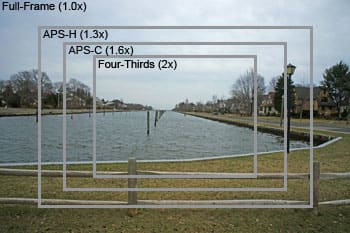
Convergance areas of different sensor sizes compared
The G2 has an automatic dust reduction system that kicks in whenever the camera is turned on. It can be performed manually by choosing Sensor cleaning in the Custom menu.
Viewfinder*(7.00)*
Unlike last year's Micro Four Thirds cameras from Panasonic, the G2 is equipped with a viewfinder. The Gf1 was compatible with on optional EVF, but that meant dropping $200 on yet another accessory for your camera—an unnecessary expense, even though the detachable viewfinder was pretty awesome.
The color LCD viewfinder on the G2 has a resolution of approximately 1,440,000 dots with a field ratio of approximately 100%. On the side of the viewfinder is a diopter adjuster with a range of -4 to +4. To the right is a sensor, which automatically turns off the LCD when you put your eye up to the viewfinder.
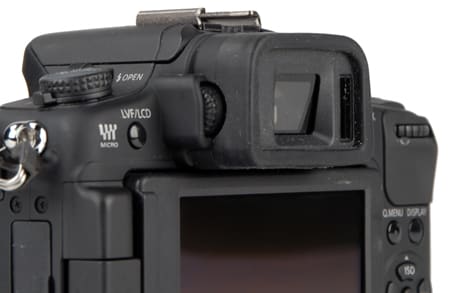
The viewfinder is a nice feature, even if it does add bulk to the camera.
LCD*(6.30)*
The LCD on the Panasonic G2 is the same as the 3-inch, 460,000-pixel screen that appeared on last year's GF1. The big improvement this year is that the LCD is articulated, allowing the user to turn it around for safe storage (or when you're using the LCD) or bring it out from the camera body and rotate it for more viewing angles. This is extremely useful if you're doing any self-recording or trying to grab a high or low vantage point for shooting.
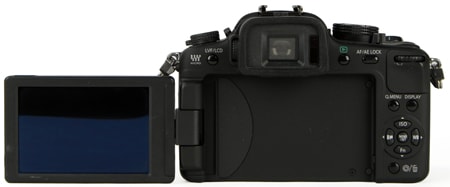
The articulated LCD panel really comes in handy.
The image on the LCD looked fine when shooting in most lighting conditions, but the refresh rate did slow down in lower lighting. In those cases, or when glare on the LCD becomes a problem, it might be easier to use the built-in viewfinder.
There are two optional modes for adjusting screen brightness to fit the shooting environment: Auto Power LCD and Power LCD. The former reacts to detected light levels, while the latter turns brightness to full blast—very handy when shooting in bright outdoor lighting.
LCD Panel
The small monochrome LCD often found on the top of higher-end traditional SLRs to display camera settings is not present on the G2—as is to be expected. The compact body doesn't offer enough real estate for this feature.
Flash*(7.50)*
Unlike the most of the Micro Four Thirds competition, Panasonic continues to tuck a flash into this compact little camera body. The built-in pop-up flash snaps up at the flick of a switch and is nestled right around the accessory shoe. It's in a different position than the off-centered flashes on last year's GF1, but Panasonic enthusiasts will recognize the clever design from the GH1.
The flash is located high above the lens when extended, to minimize red-eye and shadows from the lens. The autoexposure system never causes the flash to pop up on its own, which is just fine with us. (The G2 won't volunteer its flash in unwanted shooting scenarios.) Maximum sych speed when shooting in forced flash mode is 1/160 of a second.
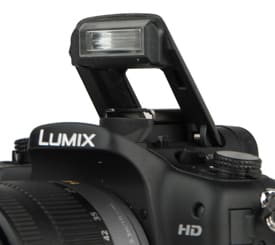
*The built-in flash is cunningly concealed.
*
All the flash controls you'd expect in a well-outfitted SLR are included here:
When not using red-eye reduction, the flash can be set to second curtain sync, which produces a trailing light effect when shooting moving cars and similar subjects.
Flash output can be manually adjusted, in a ±2 EV range, in 1/3 EV increments.
Lens Mount*(8.00)*
Micro Four Thirds lenses are about 6mm narrower than Four Thirds lenses. Some Four Thirds lenses (along with Leica lenses and others) can be attached to Micro Four Thirds bodies, but only lenses that work with contrast detect autofocus are fully compatible. A complete listing of compatible lenses is available at the Panasonic site here.
The list of Panasonic lenses compatible with the company's Micro Four Thirds system is steadily increasing in size. There are about half a dozen lenses available (not including those you can use if you buy the lens converter). The kit lens that ships with the G2 is a 14–42mm, F3.5–5.6 LUMIX G VARIO lens.
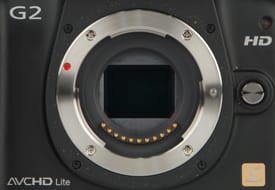
The available lens library is steadily increasing.
Battery*(6.00)*
The G2 ships with a DMW-BLB13PP lithium ion battery rated at 7.2V, 1250mAh. Panasonic gives the number of exposures per charge at 350 pictures, testing according to CIPA standards. This sounds about right to us, and we find this performance impressive, given the constant use of the power-sucking Live View display. Charging time is approximately 155 minutes.
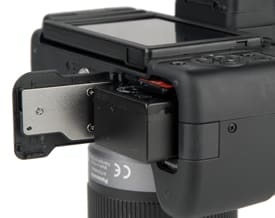
The battery and card slot share a compartment.
Memory*(3.50)*
The Panasonic G2 is compatible with standard SD/SDHC cards. Like all 2010 Panasonic camcorders and cameras, the G2 is also compatible with the new SDXC memory cards.
Jacks, Ports & Plugs*(4.50)*
Beneath a hinged rubber flap on the left side of the camera, there are two connectors: mini HDMI (a universal connection found on many high definition camcorders), and a proprietary AV connection. The G2 does not ship with an HDMI cable, but they are easily found in most electronics stores. It does, however, ship with an AV cable to fit the proprietary connection. Unfortunately, this is only a standard definition composite connection, so it won't be good for viewing your HD video footage.
Above that compartment is a smaller covering, which hides the microphone input/wired remote terminal. The microphone input can come in handy for video recording.
As an extra bonus, if you own a Panasonic television, you can use the HDMI connection to view your videos and you can use the TV remote to control camera playback.

All the ports are hiding on the left side.
Controls
Shooting Modes*(13.00)*
The regular shooting modes on the G2 are nearly identical to those offered on the G1, GH1, and GF1. It also carries over the same Custom Settings capability on those earlier models. Unfortunately, the G2 does not possess the secondary dial position for custom settings that the GF1 had. The G2 (like the G1 and GH1) has a single dial position for you custom settings.
Live View*(4.25)*
The Live View screen comes in two user-selectable layouts (via the custom settings menu), which aren't really all that different. The LCD monitor style display offers two views (toggled by pressing the Display button)/ One shows a top-and-bottom information overlay, the other has no overlay at all. The alternative, called Viewfinder style, shrinks the Live View image slightly to make room for a black bar at the bottom (as seen through a typical SLR viewfinder) with core settings overlaid in white, and a second information readout at the top, which is turned on or off by pressing Display.
Scene Modes*(7.50)*
For the G2, Panasonic has brought back the massive number of scene mode choices that were present on the GH1 (26 total). Each scene mode on the dial brings up a selection of applicable variations on that scene mode (i.e. the Portrait icon gives the user access to standard portrait, soft skin, outdoor portrait, and indoor portrait). Under the SCN choice on the dial, Panasonic has placed a handful of miscellaneous scene mode options, including Peripheral Defocus, which was new on last year's GF1.
Picture Effects*(4.50)*
The G2 offers nine preset film modes, six in color and three in black and white. For color, these include Standard, Dynamic, Nature, Smooth, Nostalgic and Vibrant; for black and white there is Standard, Dynamic and Smooth. We have samples of the same scene shot in each of these modes in the Sample Photos section, under Film Mode Examples.
Each color preset mode can be adjusted for contrast, sharpness, saturation and noise reduction, with five steps for each setting. The black and white modes work the same way, except there is no saturation control. Having noise reduction as a film mode setting rather than an overall camera setting is an odd choice, making changes less convenient than the more typical procedure. You're also prevented from turning off noise reduction completely, as we often do when trying to tease out as much image detail as possible.
Multi Film bracketing is an interesting feature that lets you select two or three different Film Mode settings and take shots in each one consecutively. Unlike white balance bracketing, you don't take a single shot and have it saved in different versions: in this case, you'd have to press the shutter repeatedly or set the camera to burst mode.
My Color mode, a beginner-friendly feature found on previous Panasonic cameras, has the same upgrades as last year's GF1. In the earlier version, the user gets to set color, brightness and saturation, each along an eleven-step scale, with the results previewed interactively on screen (as you'd imagine, this substitutes for Film Mode settings). These options are still available by choosing Custom when the mode dial is set to My Color, but there are also seven presets that work much like the artsy filters found on Olympus and Pentax cameras. The My Color settings can be applied to still or video shooting.
We've illustrated six of the My Color settings in the chart below, with Panasonic's own explanation of the effect provided. The descriptions are helpful and also sometimes strangely poetic.
To better demonstrate the Silhouette preset we set up a different type of shot. As seen below, the photo on the left maintains some color and detail when shot in program mode. Switching to the Silhouette setting in My Color simplifies the image, emphasizing the geometric shapes by eliminating gradation between values.
Focus*(19.25)*
Autofocus performance has been a key strength of the Lumix G series from the start, and this continues with the G2. The Live View autofocus on most digital SLRs is too slow to be practical when shooting moving subjects. Panasonic, though, has figured out how to make contrast detect autofocus nearly as fast as the standard SLR phase detect system, and certainly workable for all but the most sports-oriented photography. This is an area where the G2 has a clear advantage over the Olympus E-P1, which suffers from pokey autofocus speeds.
The continuous autofocus in video mode pioneered on the GH1 is also implemented on the G2. The autofocus system supports four modes, which may be selected via a dedicated dial on the top of the camera:
Beneath the Focus Modes dial is a secondary dial, which allows you to select between AF-S (autofocus single), AF-C (continuous), and MF (manual focus). AF-S focuses when you press the shutter halfway and maintains that setting, even if you move the camera. AF-C keeps refocusing as necessary while you hold the shutter down, even if your subject moves, or you move the camera. Yet another set of autofocus options are prefocus settings, available through the custom settings menu. Here you can choose from Q-AF (Quick Autofocus), which tries to autofocus whenever the camera is held still, and C-AF (Continuous Autofocus), which attempts to maintain focus at all times, even if the camera is moving and your finger is nowhere near the shutter button, with compatible lenses. Confusing terminology rules here: having both Autofocus Continuous and Continuous Autofocus as distinct choices isn't playing fair.
There's a bright red autofocus assist lamp on the front left, which does a nice job when the lights are low. However, the positioning isn't perfect. It's very easy to cover up the lamp with your right middle finger while shooting, especially if you have large hands. It's also slightly off-center, so your subject won't be evenly illuminated if s/he is in the center of the frame.
Of course, there's also a manual focus mode, chosen via secondary focus dial up top. By default, a zoomed-in view of the scene (up to 10x magnification) appears when you start focusing manually, returning to normal view when you depress the shutter button halfway. In certain circumstances (when shooting on a tripod, for example) we found this useful, though having the rest of the screen disappear while trying to manually focus on a moving subject is less practical. You can also set the camera to allow fine manual focus adjustment after the autofocus system has done its business.
Panasonic continues with its odd variant to face detection, which it calls face recognition. You can register up to six faces in the camera's built-in memory, complete with name, birthday and a priority rating if you choose. Then, when the feature is turned on during shooting, those registered faces will be given preferential treatment when focusing and setting exposure. The name can even be displayed on screen, for no apparent reason. The face recognition concept does have some interesting benefits, though. When taking group photos (at a school concert, for example), it will help make sure your little darling is in focus rather than some random kid. And during playback, it's possible to view only images which include recognized faces.
Exposure*(5.50)*
The exposure compensation range is ±3 EV, in 1/3 stop increments. Accessing exposure compensation is easy: click the rear control dial, then turn it to enter an exposure compensation setting. You don't have to hold down a button when changing this setting, a definite plus. And while the original G1 dial was easy to click accidentally, pressing the G2 control requires enough oomph to solve this problem. Exposure comp is also available through the quick menu system.
Panasonic calls its dynamic range adjustment system Intelligent Exposure, abbreviated i.Exposure. There are three adjustment levels available, offering increasingly aggressive processing of high-contrast images at the expense of increasing image noise.
Speed and Timing
Shot to Shot (3.43)
Panasonic claims that the camera can achieve a top burst rate of 3.2 shots per second. Our lab tests showed just about the same results. The G2 shot an average of 3.43 fps in our burst test.
Drive/Burst Mode (7.50)
The G2 supports three burst mode settings: High, Medium, and Low. The medium speed captures photos at approximately 2.6 fps, while the low speed achieves about 2.0 fps. When the camera is set to AFC mode, the camera will adjust focus between shots, cutting the burst rate.
Depth of Field Preview*(4.00)*
With so many midrange SLRs dropping depth of field preview altogether, we're pleased to see Panasonic has not only come up with a very effective implementation of the feature, but added a unique shutter speed preview as well. Pressing the Aperture/Image Delete button while shooting stops down the lens to the current aperture setting, so you see what will actually be in focus when you take the shot. If you then press the Display button it takes you to shutter speed preview mode, which displays a series of images sequentially to preview the level of blur there would be in your photos if you shot at current settings. It's an interesting interactive way to figure out how to stop the action (of whirling ceiling fan blades, for example), or capture the degree of blurriness you want for artistic effect.
Metering*(8.50)*
The GF1 uses a 144-zone metering system, with three available modes:
An exposure meter display can be overlaid roughly two thirds of the way down the Live View screen, displaying shutter speed and aperture horizontally.
Shutter Speed*(10.00)*
Available shutter speeds range from a 1/4000th second to 60 seconds, plus bulb exposure to a maximum of four minutes.
Self-Timer*(3.50)*
In addition to the basic 10-second and 2-second shutter delay options, you can also choose to have three consecutive shots taken after a 10-second delay, handy if you're racing to get into the photo.
A wired remote, the DMW-RSL1, is available for about $20. The port for the wired remote is hidden in a separate compartment on the left side of the camera. The G2 doesn't support a wireless remote control.
Other Features*(1.00)*
Audio Recording
The mic can be used to record 5 seconds of audio along with a photo. This is a useful feature when you want to make a note about the shooting situation without fumbling for a pen and paper. Audio annotations can also be added during image playback.
Design & Handling
Handling*(8.25)*
The Micro Four Thirds format certainly offers a more compact design than many traditional SLRs, but it is far from the compact shooting experience you might expect from a true compact camera. The most significant difference between an SLR and a Micro Four Thirds camera is in the depth. Removing the SLR mirror mechanism cuts the depth of the G2 nearly in half, compared to many SLRs currently on the market. Of course, if you choose to attach a large lens to the front of the camera, and inch or so of depth doesn't make much of a difference. So, in this case, size doesn't really matter.
What is good on the G2 is the overall balance and comfort. The form factor is very similar to that of the GH1 and G1. It feels substantial in your hands, with enough weight to sit comfortably. If you have larger hands, you might be disappointed in the depth of the grip; wrapping your fingers all the way around the grip causes your index finger to be out of alignment with the shutter button. We also wouldn't have minded some extra texture on the grip. The surface of the camera is highly resilient to greasy fingerprinting and scratches, but it can get a bit sweaty on long, hot photoshoots.
Perhaps the greatest advantage to the G2 is its pivoting LCD panel, which lets you shoot easily from a number of different angles.
Controls*(9.50)*
Shooting with the original G1, we found the control dial was too sensitive, leading us to click it accidentally and change the exposure compensation settings. In the new model, there seems to be more resistance, which has resulted in the problem being erased entirely. We were also relieved to find that the video record button remains on the top of the camera, out of harm's way, where it was directly above the thumb rest on last year's GH1. We strongly prefer this design.
Menu*(7.50)*
The G2 offers direct access to several key shooting controls, including ISO, white balance and focus mode, via buttons on the back of the camera. Most of the other frequently changed settings in record mode, including film mode, image size and flash control, are a single button-press away, via the Quick Menu system (which has its own dedicated button). The Quick Menu system makes the information overlay on the Live View screen interactive, navigable with the control dial or four-way controller. To change a setting, you press the Menu/Set button.
For the remaining settings, there's a typical multi-part menu system. The menus are easy enough to read, color coded for quick identification, and settings include both icons and legible text, so you're never stuck guessing what a line item controls. However, each menu can run up to five screens deep, meaning a lot of scrolling and searching before you find what you're after.
Manual & Learning*(4.50)*
The 220-page Operating Instructions manual isn't bad, but there are some peculiarities. It's certainly not a book intended to be read cover-to-cover, as some of the early information is a bit obscure for beginners. The index and table of contents, however, don't list everything you would expect. Movie and video is referred to as 'motion picture' and some things just aren't present. If you come across an option in the camera that you don't understand, it's very easy to look this up. If, however, you just want to know how to do something but you don't know Panasonic's term for it, you might be in trouble.
On the plus side, there are lots of illustrations and every specific setting is explained in excellent detail. You can download a pdf of the manual here.
Video Color & Noise
**Video: Color Performance***(8.14)*
The Panasonic G2 registered a color error of 4.3 and a saturation level of 90.1% in our bright light testing. This score is a solid showing, but it's nothing exceptional. Some of the comparison models had slightly more accurate colors, but there have been many models that have produced worse numbers in this test. Click here for more on how CamcorderInfo.com tests color performance.
The Color Error Map (above right) shows that the G2 was able to render blue and red colors with very good accuracy. It was greens and yellows, however, that gave the camera some trouble. The camera's 90.1% saturation level is quite good for an auto mode performance, but the Panasonic G2 also has a bunch of extra color modes that produce a varied color performance. We did all of our testing using the Standard color mode and the AVCHD compression option, but we have examples of the other color modes below.
The Panasonic G2 did produce a slightly brighter image when we recorded video using its Motion JPEG compression setting as compared to its AVCHD option. The color accuracy and saturation levels showed no significant difference, however. Of the models shown below, only the Olympus E-PL1 produced an image that could be described as having below average color accuracy. The other cameras all did quite well in this test.
**Video: Noise Performance***(13.32)*
The Panasonic G2 was a very strong performer in our bright light noise test. The camera measured a minuscule 0.195% noise in its bright light image, which is one of the lowest amounts of noise we've seen in this test. However, this low noise level is partially due to the fact that the G2 captured a slightly blurred image in bright light (see the sample image below). Click here for more on how CamcorderInfo.com tests noise performance.
Since all of the cameras shown above top out with 1280 x 720 recording resolution (rather than Full HD 1920 x 1080), it shouldn't be much of a surprise that they didn't capture an ultra-sharp image in our testing. The Panasonic G2 has a smooth, yet slightly blurred image that almost appears out of focus, while the Samsung NX10 produced a terribly discolored image when you look at the crop.
Video Motion & Sharpness
Video Low Light
**Video: Low Light Sensitivity***(0.80)*
The G2 needed 24 lux of light to record an image that registered 50 IRE on our waveform monitor. This isn't a great showing for the camera, but it matches up with what we saw from the other models in this set. Only the Samsung NX10 was able to produce the same IRE levels with less than 20 lux of light (it needed 19 lux to reach 50 IRE). What does this all mean? Well, it means that none of these models are top-notch performers when it comes to low light sensitivity, so the Panasonic G2's performance isn't all that bad in comparison. We should also note that there was no difference in the low light sensitivity on the Panasonic G2 when we shot using the camera's MJPEG compression mode in comparison to its AVCHD setting. Click here for more on how CamcorderInfo.com tests low light sensitivity.
Since all of these cameras feature interchangeable lens systems, you should keep in mind that much of what determines low light sensitivity has to do with the kind of lens you are using. Attaching a faster lens (with a wider aperture) should give any of these models a significant boost in low light as they would allow more light to hit the image sensor.
**Video: Low Light Color Performance***(5.11)*
While the Panasonic G2's low light image looked rather good, the camera wasn't able to reproduce colors with terrific accuracy. The camera managed a color error of 6.71 in our low light test, although it did put up a strong saturation level of 102.5%. Click here for more on how CamcorderInfo.com tests low light color performance.
We like the fact that the G2 was able to capture deep, vivid colors in low light—even if those colors registered as fairly inaccurate according to our image testing software. You can always tweak the color controls on the camera by selecting a different color mode or by manually adjusting color settings. The Panasonic G2 also produced a decently bright image in our low light color test (which is shot at 60 lux). Check out the comparison images below to see what we're talking about.
**Video: Low Light Noise Performance***(11.67)*
The G2's best showing in our battery of low light tests came from its strong performance in low light noise. The camera averaged 0.7525% noise, which is a good score that is just above average for a camera of its class. Click here for more on how CamcorderInfo.com tests low light noise performance.
Looking at the cropped images above, you can see that the Panasonic G2's image—while not terrible—definitely has its problems. There isn't much noticeable noise on the image, but there is some discoloration and blur. The thing is, all of the cameras shown above have similar problems, although none of them come close to the poor image quality captured by the Samsung NX10. Basically, our point is if you're looking for top-notch low light performance, you should stray away from all of these cameras.
Video Features
**Video: Compression***(8.00)*
Like the Panasonic GF1 and GH1 before it, the G2 offers two compression options for recording HD video: AVCHD Lite and Motion JPEG (MJPEG). These two options are identical to what Panasonic included on the GF1. The AVCHD Lite compression is essentially the same as regular AVCHD compression, which is popular on consumer HD camcorders. We did, however, run into some compatibility issues with the AVCHD Lite compression system. When we played back AVCHD Lite clips on our computer, the videos played at double speed, which we think is a problem associated with the 60p frame rate the camera uses in AVCHD Lite mode (the sensor output is 30 frames per second). AVCHD Lite clips played back on a television looked fine, though, so this issue only came about after we imported the video clips to a computer.
If you want to avoid the problems with the AVCHD Lite compression, you can record video using the G2's Motion JPEG compression option. We found the MJPEG videos to have a bit more artifacting than the AVCHD Lite videos, but color accuracy, noise levels, and low light sensitivity all came out nearly identical with the two modes.
**Video: Manual Controls***(5.75)*
Auto Mode
The Panasonic G2 does have a continual autofocus system, which is something that is becoming more common to find on video-capable DSLRs (especially on Micro Four Thirds models). The autofocus doesn't work nearly as fast as it does on most consumer camcorders, but it does produce accurate results and smooth focus transitions. If you're looking for snap-like focus changes, however, then you will be disappointed with the G2. Of the video-capable DSLRs we've tested, the Sony NEX-5 had the best autofocus system.
Auto exposure also works smoothly and accurately, although it only does this *during *recording. Prior to pressing the record button the camera will quickly change exposure levels when moving from light to dark scenes (or vice versa). This may be a problem if you are trying to plan out a shot with exposure changes. The other auto controls on the camera, particularly the auto white balance, all seem to work without any glaring weaknesses.
Zoom Controls and Zoom Ratio
Zoom is controlled by using the zoom ring on the G2's attached lens. The amount of zoom offered is entirely dependent on what lens you have connected, but the kit lens is a 14 - 42mm lens, which translates to a 3x optical zoom.
The camcorder also has an extended optical zoom setting that can be turned on in video mode. What this does is it bumps up the magnification right off the bat (before you start recording or zooming with the zoom ring). This setting increases the amount of zoom possible with the camera to 9.4x. There are also two digital zoom options on the camera that allow you to increase zoom by 2x or 4x. According to Panasonic there should be no deterioration in image quality when using the extended optical zoom feature, but the digital zoom options will degrade picture quality.
Focus
As we stated above, the G2 does have a live autofocus function. You can also set focus manually using the lens ring, or you can activate an autofocus by pressing the shutter halfway down. Since the autofocus sometimes works slowly, you may want to use manual focus if you're recording a planned-out shot.
Exposure, Aperture, and Shutter Speed
Exposure can be set on the camera quite easily, and it can be done so during recording (always a good thing). When you set the exposure manually, it does take the camera a bit of a moment to adjust the levels. There isn't too much of a delay, it's just that the levels don't change instantaneously.
There is no manual shutter speed control on the camera in video mode, but aperture can be set using what Panasonic calls 'peripheral defocus' control. This feature can only be set in movie mode and you don't actually see the f-stop values you are setting the camera to. All you see is a little bar that shows depth of field. While this simplified system may be helpful for some users, we find it a bit odd. We wish Panasonic would include regular aperture control (with f-stop values) in addition to the 'peripheral defocus' option.
ISO* and Other Controls*
There's no manual ISO control in video mode, but you can set white balance manually or select a specific Kelvin color temperature. The full set of color controls (called film modes) are also available when recording video. You can see examples of these color modes in the Video: Color section of this review.
Other controls that work in video include a stabilization setting, three levels of intelligent exposure (low, medium, and high), and three exposure metering modes (spot, center weighted, or multi).
While the built-in microphone on the Panasonic G2 isn't anything to write home about, the fact that the camera has an external microphone input is something rather unique for a camera of its class. The built-in mic on the G2 records mono audio and it picks up tons of extraneous operational sounds during recording. If you want to capture stereo audio, however, you can purchase the optional DMW-MS1 microphone that attaches to the G2's accessory shoe and via a cable into the camera's external mic input. It is unclear as to whether a third-party microphone is compatible with the camcorder, but the external mic input is not the normal 3.5mm size (it is a smaller, 2.5mm jack).
In addition to the external mic jack, the Panasonic G2 also has a wind cut feature that can be turned on to reduce wind noise. You can read a complete list of audio features in the table below.
The rotatable LCD on the Panasonic G2 is simply fantastic for video recording. You can manipulate the LCD in a variety of different ways, which means getting high or low-angle shots shouldn't be a problem with the camera (something you can't say about models with stationary LCDs). If you like using the viewfinder instead of the LCD, you also have that option on the Panasonic G2. That's what we like about the G2's LCD/viewfinder setup—there's lots of versatility and choice for the user.
The continual autofocus system, while an impressive feature, isn't as quick as we'd like it to be. You definitely get better autofocus from a traditional camcorder, but as far as video-capable DSLRs go, the G2 had one of the best systems we've seen (the Sony NEX-5 did even better, though).
The G2 is a fairly light camera, but its grip isn't the best. There's no ribbing or textured material on its body, which makes the right side somewhat slippery. This may not be a problem with still photography, but if you're planning on holding the camera for a long video shoot it might become an issue.
There aren't too many video controls on the G2, so you can ignore most of the buttons other than the dedicated start/stop record button and the adjustment dial that's used to set exposure and peripheral defocus. The Quick Menu is a great feature in video mode because it gives you easy access to all of the camera's movie options. It isn't the easiest thing to navigate, but you get the hang of it pretty quickly.
Olympus E P1 Comparison
NOTE: The images above are not used in our testing or scoring, but are included here to show real-world examples of the differences between cameras at the various ISO settings.
Samsung NX10 Comparison
NOTE: The images above are not used in our testing or scoring, but are included here to show real-world examples of the differences between cameras at the various ISO settings.
Sony NEX 5 Comparison
NOTE: The images above are not used in our testing or scoring, but are included here to show real-world examples of the differences between cameras at the various ISO settings.
Panasonic GF1 Comparison
NOTE: The images above are not used in our testing or scoring, but are included here to show real-world examples of the differences between cameras at the various ISO settings.
Conclusion
Meet the tester
Vice President of Editorial Management, Kaitlyn oversees the editorial departments of Reviewed.com’s various sites. She has been writing about technology since the turn of the century. Outside of her Reviewed.com home, Kaitlyn is also a theatre director and avid gamer.
Checking our work.
Our team is here to help you buy the best stuff and love what you own. Our writers, editors, and experts obsess over the products we cover to make sure you're confident and satisfied. Have a different opinion about something we recommend? Email us and we'll compare notes.
Shoot us an email